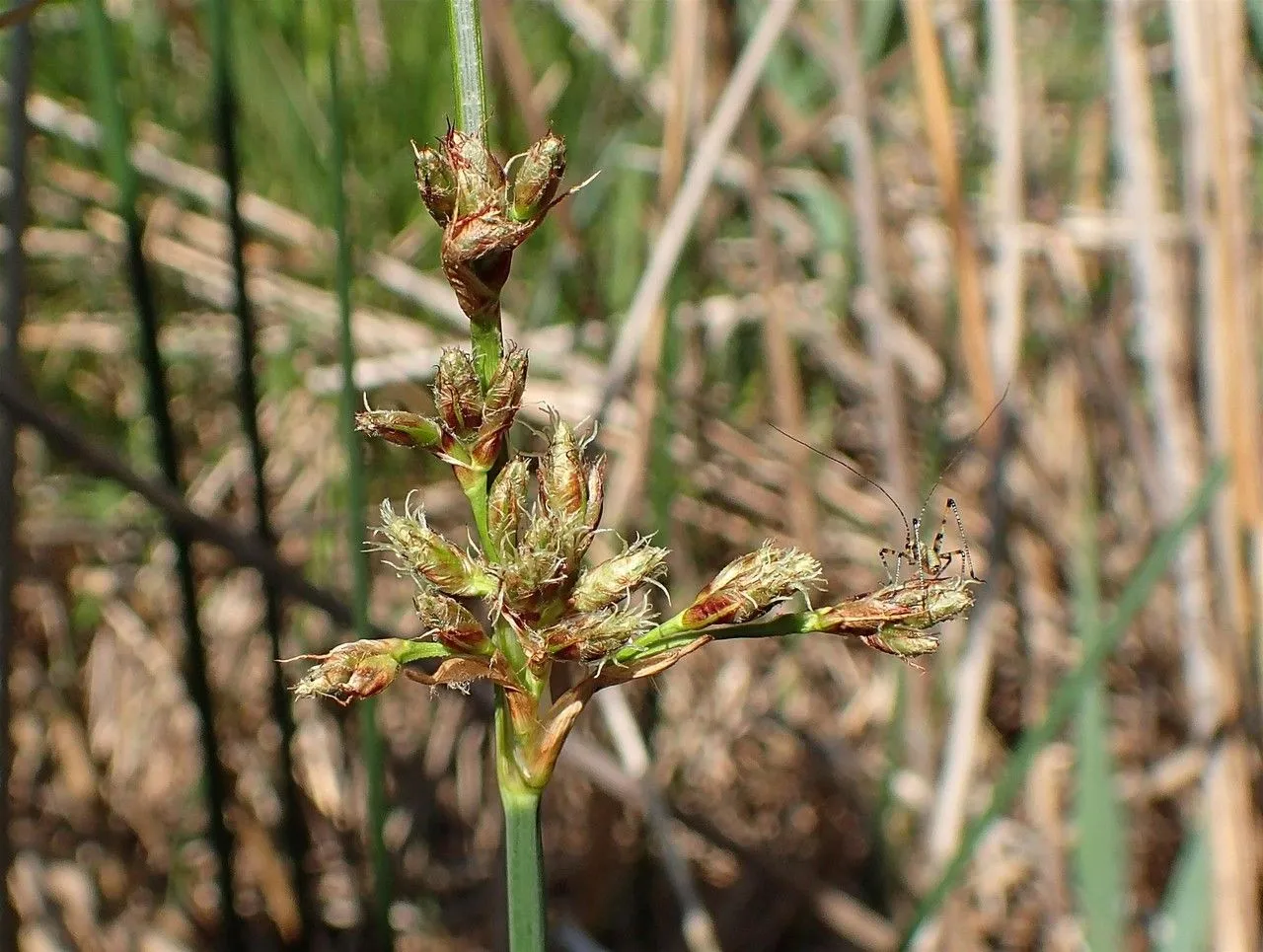
Author: (C.C.Gmel.) Palla
Bibliography: Bot. Jahrb. Syst. 10: 299 (1888)
Year: 1888
Status: accepted
Rank: species
Genus: Schoenoplectus
Vegetable: False
Observations: Cosmopolitan
The great bulrush, scientifically known as Schoenoplectus tabernaemontani, is a versatile and widespread plant species belonging to the family Cyperaceae. First described in detail in the 1888 issue of “Botanische Jahrbücher für Systematik,” this species was authored by Palla, basing his work on the initial classification by C.C. Gmel.
Renowned for its cosmopolitan distribution, the great bulrush thrives in a variety of wetland habitats across the globe. It is commonly found in marshes, along the edges of ponds and lakes, and in slow-moving streams. The plant plays a critical role in its ecosystem by providing habitat for wildlife, stabilizing soil, and contributing to nutrient cycling.
Characterized by its tall, slender stems which can reach impressive heights, Schoenoplectus tabernaemontani exhibits a perennial growth habit. Its ability to grow in dense clusters makes it an excellent natural barrier against erosion, while its deep-rooting system allows it to maintain structural integrity in waterlogged soils.
The great bulrush features narrow, cylindrical leaves that are often hollow and spongy, allowing them to float and sway with the movement of water. During the blooming season, it produces small, inconspicuous flowers that form in dense clusters at the tops of the stems. These flowers subsequently develop into nut-like fruits, aiding in the plant’s reproduction and dispersal.
Given its wide distribution and ecological significance, Schoenoplectus tabernaemontani is not only a subject of interest for botanists and ecologists but also a valuable plant for water management and conservation projects. Its ability to filter pollutants and enhance water quality makes it a pivotal component of constructed wetlands designed for wastewater treatment.
In summary, the great bulrush is a remarkable plant species noted for its adaptability, ecological benefits, and wide-ranging presence across the globe. Understanding and preserving this vital species is fundamental to maintaining healthy wetland ecosystems.
Dan: blågrøn kogleaks
Deu: graugrüne teichsimse, salz-teichsimse
Eng: great bulrush, grey club-rush, river club-rush, soft-stem bulrush, softstem bulrush, soft-stemmed bulrush, american great bulrush, common great bulrush, glaucous club-rush, greyish bulrush, sea club rush, great american bulrush
Swe: blåsäv
Nld: ruwe bies
Fra: scirpe des étangs, scirpe glauque, souchet de tabernaemontanus, jonc des chaisiers glauque, schoenoplectus de tabernaemontanus, scirpe vigoureux
Cym: clwbfrwynen glasbeilliog, clwbfrwynen llwydwyrdd, clwbfrwynen oleulas, llafrwyn arfor, llafrwynen arfor, tostfrwynen arfor
Mri: kuawa
En: Great bulrush, Grey club-rush, River club-rush, Soft-stem bulrush, Softstem bulrush, Soft-stemmed bulrush, American great bulrush, Glaucous Club-Rush, Greyish Bulrush, Sea club rush, Common great bulrush, Great American bulrush
Da: Blågrøn kogleaks
Nl: Ruwe bies
Fr: Scirpe des étangs, Scirpe glauque, Souchet de Tabernaemontanus, Jonc des chaisiers glauque, Schoenoplectus de Tabernaemontanus, Scirpe vigoureux, Jonc-des-chaisiers glauque
De: Graugrüne Teichsimse, Salz-Teichsimse, Graue Seebinse, Tabernaemontanus’ Seeried
It: Lisca del Tabernemontano
Mi: Kuawa
Sv: Blåsäv
Cy: Clwbfrwynen Glasbeilliog, Clwbfrwynen Llwydwyrdd, Clwbfrwynen Oleulas, Llafrwyn Arfor, Llafrwynen Arfor, Tostfrwynen Arfor
© copyright of the Board of Trustees of the Royal Botanic Gardens, Kew.
© copyright of the Board of Trustees of the Royal Botanic Gardens, Kew.
© copyright of the Board of Trustees of the Royal Botanic Gardens, Kew.
Taken Aug 15, 2005 by Photoflora – Jean-Luc TASSET (©)
Taken Sep 15, 2004 by Photoflora – Jean-Luc TASSET (©)
Taken Aug 29, 2013 by Tela Botanica − Hugues TINGUY (cc-by-sa)
Taken Aug 16, 2018 by Jean-Michel Faton (cc-by-sa)
Taken Nov 5, 2021 by Trap Hers (cc-by-sa)
Taken May 28, 2017 by Yoan MARTIN (cc-by-sa)
Taken Aug 10, 2017 by Yoan MARTIN (cc-by-sa)
Taken Nov 5, 2021 by Trap Hers (cc-by-sa)
Taken May 28, 2017 by Yoan MARTIN (cc-by-sa)
Taken May 28, 2017 by Yoan MARTIN (cc-by-sa)
Taken Aug 10, 2017 by Yoan MARTIN (cc-by-sa)
Taken Aug 10, 2017 by Yoan MARTIN (cc-by-sa)
Taken May 28, 2017 by Yoan MARTIN (cc-by-sa)
Taken Aug 10, 2017 by Yoan MARTIN (cc-by-sa)
Taken May 28, 2017 by Yoan MARTIN (cc-by-sa)
Taken Aug 6, 2021 by Daniel Bäck (cc-by-sa)
Taken May 6, 2022 by florian Kherbouche (cc-by-sa)
Taken Jun 24, 2021 by Sophie Pi (cc-by-sa)
Taken Jul 10, 2022 by Bennik kolin (cc-by-sa)
Taken Aug 16, 2018 by Jean-Michel Faton (cc-by-sa)
Taken Aug 15, 2007 by Photoflora – Yann QUELEN (©)
Taken Aug 15, 2002 by Photoflora – Benoit BOCK (©)
Taken Jan 1, 1970 by Photoflora – L’Abbé COSTE (©)
Taken Aug 15, 2015 by Photoflora – Benoit BOCK (©)
Taken Jun 30, 1873 by Tela Botanica − Herbier PONTARLIER-MARICHAL (cc-by-sa)
Growth form: Rhizomatous
Growth habit: Graminoid
Growth rate: Rapid
Ph maximum: 7.5
Ph minimum: 5.4
Light: 8
Atmospheric humidity: 8
Soil nutriments: 6
Soil salinity: 3
Family: Myrtaceae Author: (F.Muell.) K.D.Hill & L.A.S.Johnson Bibliography: Telopea 6: 402 (1995) Year: 1995 Status:…
Family: Rubiaceae Author: Pierre ex A.Froehner Bibliography: Notizbl. Bot. Gart. Berlin-Dahlem 1: 237 (1897) Year:…
Family: Sapindaceae Author: Koidz. Bibliography: J. Coll. Sci. Imp. Univ. Tokyo 32(1): 38 (1911) Year:…
Family: Asteraceae Author: A.Gray Bibliography: Pacif. Railr. Rep.: 107 (1857) Year: 1857 Status: accepted Rank:…
Family: Fabaceae Author: Medik. Bibliography: Vorles. Churpfälz. Phys.-Ökon. Ges. 2: 398 (1787) Year: 1787 Status:…
Family: Aspleniaceae Author: (Cav.) Alston Bibliography: Bull. Misc. Inform. Kew 1932: 309 (1932) Year: 1932…